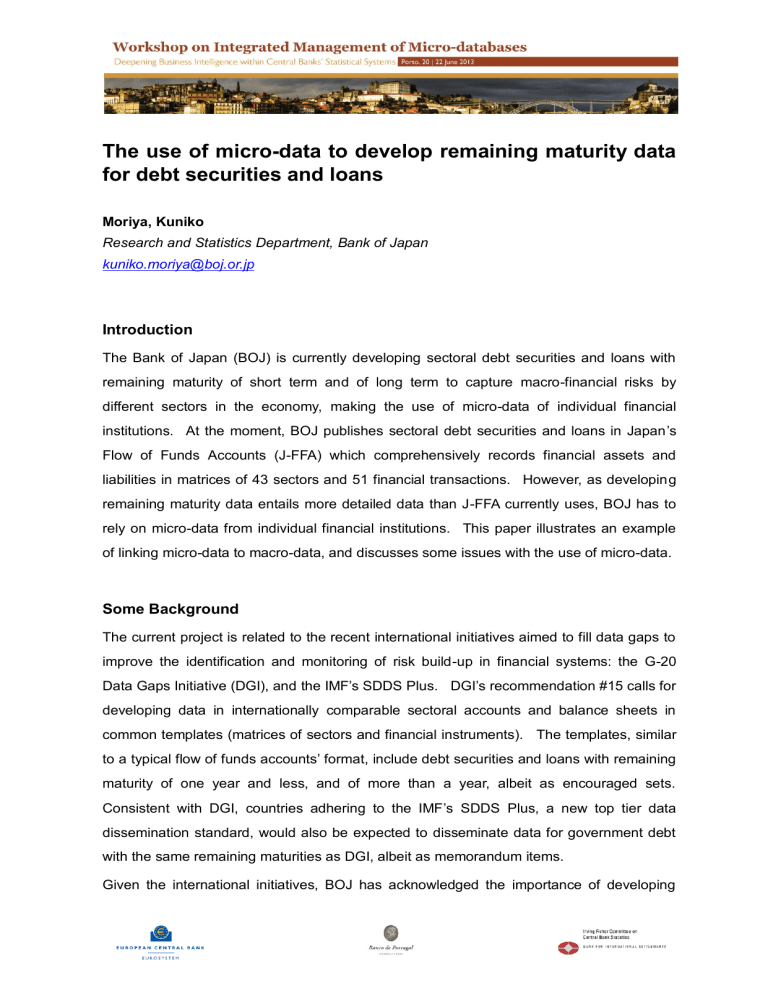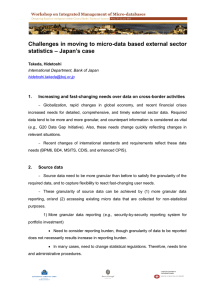The use of micro-data to develop remaining maturity data Introduction

The use of micro-data to develop remaining maturity data for debt securities and loans
Moriya, Kuniko
Research and Statistics Department, Bank of Japan kuniko.moriya@boj.or.jp
Introduction
The Bank of Japan (BOJ) is currently developing sectoral debt securities and loans with remaining maturity of short term and of long term to capture macro-financial risks by different sectors in the economy, making the use of micro-data of individual financial institutions. At the moment, BOJ publishes sectoral debt securities and loans in Japan ’s
Flow of Funds Accounts (J-FFA) which comprehensively records financial assets and liabilities in matrices of 43 sectors and 51 financial transactions. However, as developing remaining maturity data entails more detailed data than J-FFA currently uses, BOJ has to rely on micro-data from individual financial institutions. This paper illustrates an example of linking micro-data to macro-data, and discusses some issues with the use of micro-data.
Some Background
The current project is related to the recent international initiatives aimed to fill data gaps to improve the identification and monitoring of risk build-up in financial systems: the G-20
Data Gaps Initiative (DGI), and the IMF ’s SDDS Plus. DGI’s recommendation #15 calls for developing data in internationally comparable sectoral accounts and balance sheets in common templates (matrices of sectors and financial instruments). The templates, similar to a typical flow of funds accounts
’ format, include debt securities and loans with remaining maturity of one year and less, and of more than a year, albeit as encouraged sets.
Consistent with DGI, countries adhering to the IMF ’s SDDS Plus, a new top tier data dissemination standard, would also be expected to disseminate data for government debt with the same remaining maturities as DGI, albeit as memorandum items.
Given the international initiatives, BOJ has acknowledged the importance of developing
remaining maturity data, respecting and fulfilling international data dissemination standards although reporting is on a voluntary basis. Independently, BOJ considers those data as useful for capturing Japan ’s financial and economic structures in its own merit. In fact,
BOJ proceeds to additionally develop data of bank deposits with remaining maturities and loans by different types of interest rates (fixed and floating) to help identify and monitor the build-up of financial risks.
Data Availability and Data Collection
Macro-data of debt securities and loans by remaining maturities currently available in
Japan are quite limited. A readily and publicly available macro-data source is “Financial
Statements Statistics of Corporations by Industry (FSSC), ” in which the Ministry of Finance
(MOF) compiles loans to non-financial corporations. Other macro-data sources include
Japan Securities Depository Center (JASDEC), which stores book entry transfer data for corporate securities and “Debt Management Report (DMR),” in which MOF publishes data on government bonds. With those data sources, we will be able to fill in most cells in the template on the liabilities side.
Table 1 . Data Sources for Compiling Statistics
Assets (holding) side Liabilities (issuance) side
Debt securities Micro-data of financial institutions JASDEC, MOF (DMR)
Loans Micro-data of financial institutions MOF (FSSC)
In contrast, to fill in sectors on the assets side, we have to rely on micro-data, taking into account the reporting burden incurred by financial institutions. Although not systematically collected by BOJ, certain types of financial institutions are, by regulations, required to disclose data of debt securities and loans by remaining maturities: for example, the
Banking Act applies to deposit-taking financial corporations and the Insurance Business Act to insurance corporations. For other types of financial institutions, credit unions, albeit not obliged by regulations, internally collect data of debt securities and loans for their own purpose of risk management. Although not required, most financial institutions have agreed to report their data to BOJ on a voluntary basis – otherwise, we would have to collect data from some 500 individual financial institutions ’ financial statements and reports by incurring a tremendous amount of administrative costs.
2
From Micro- to Macro-Data
With the micro-data of financial institutions as well as the existing macro-data described above, we will be able to estimate the following items in the template: on the assets side, for debt securities and loans, deposit-taking financial corporations, insurance corporations, and public financial corporations; on the liabilities side, all domestic sectors for debt securities, and non-financial corporations for loans.
On estimation, after compiling micro-data, we calculate ratios between debt securities/loans with remaining maturity of one year and less, and of more than a year for subsectors. We then calculate macro-data in subsectors by multiplying those ratios with amounts outstanding in corresponding sectors in J-FFA (Table 2).
Table 2.
Derivation from J-FFA Data (Rec. #15 Template, partial)
F1 Monetary gold and SDRs
F2 Currency and deposits
F3 Debt securities (D)
One year and less
More than a year
F4 Loans (L)
One year and less
More than a year
Non-Financial
Corporations
Financial
Corporations
General
Government
Households
Data avairable in J-FFA
Data avairable in J-FFA
Data avairable in J-FFA a/(a+b), calculated from micro data, times D b/(a+b), calculated from micro data, times D
Rest of the World
Data avairable in J-FFA c/(c+d), calculated from micro data, times L d/(c+d), calculated from micro data, times L
・
・
Issues with Micro-Data
One important issue surrounding the use of micro-data is administrative costs to collect and process micro-data. Accordingly, in cases where micro-data are not readily available or costs of data collection outweigh benefits for corresponding sectors in J-FFA, ratios for certain components are applied to impute their subcomponents. For example, if deposittaking financial corporations consist of domestic and foreign banks, ratios for the former can be applied to impute the latter rather than collecting individual foreign banks
’ data. In fact, amounts outstanding for foreign banks in Japan are small enough to reasonably use such an imputation method without significant impacts on outcomes.
Another issue is that calculating methods of
“remaining maturity” data vary across
3
individual institutions, as the Banking Act does not stipulate them. While debt can be repaid all at once at the end term ( “redemption at maturity”) or by a series of instalments with predetermined schedule over the course of borrowing period ( “scheduled repayment”), when recording debt on their books with the latter case, financial institutions could choose
“redemption at maturity” as well as “scheduled repayment.” Accordingly, as illustrated in
Figure 1 below, outcomes reported by individual financial institutions could vary, depending on which methods to use. Instead of painstakingly investigating all individual financial institutions, after examining various sized samples, we have concluded that it is statistically acceptable to proceed with existing differences in reporting methods as differences would have negligible impacts on estimated ratios between remaining maturities.
Figure 1. Illustrated Example of Different Calculations of Remaining Maturities
(Face value: 100; Maturity: 5 years)
Year 1
100
80
60
40
20
0
0 20
Year 2
Redemption at maturity
Scheduled repayment
0 20
Year 3
0 20
Year 4
Year 5
(Maturity end)
100
0 20 20
Different outcomes calculated for installment debt
Redemption at maturity
Scheduled repayment
One year and less
0
20
More than a year
100
80
Concluding Remarks
BOJ has been working on a project to develop sectoral data of debt securities and loans with different remaining maturities by collecting micro-data from individual financial institutions as well as by making the use of the existing macro-data. BOJ is currently in the midst of collecting data from financial institutions with publication projected early 2014.
Using micro-data to develop macro-data has unveiled some specific issues such as projecting micro-data into macro-data, and standardizing data definitions across individual reporting parties. Furthermore, as we recognize the burden incurred from reporting micro-
4
data can be significant, it is only after exhausting all the possibilities to use publicly available data, should we then consider choices of micro-data. While needs to fill in data gaps are ever increasing as evident from the recent international initiatives such as G-20 ’s
DGI and IMF ’s SDDS Plus, BOJ continues to improve and develop financial statistics it publishes by weighing benefits for users and costs for reporting parties.
5



